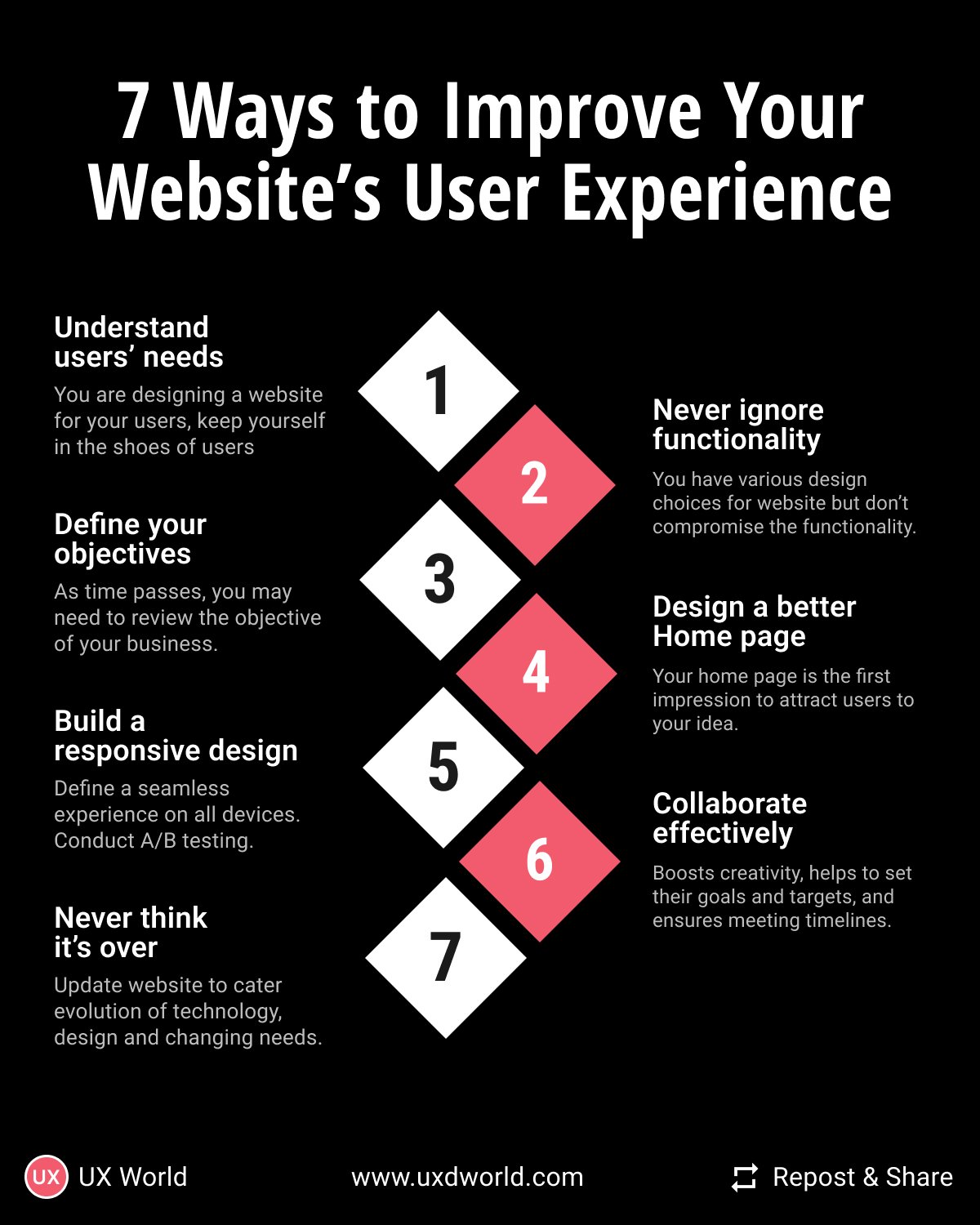Last Updated on July 22, 2024 by UX World
Web design in the modern era has become more challenging due to the competitive environment. To compete in this era, you must be capable of tackling the latest trends and designing a unique user experience that can take the lead in the market.
In this article, you will learn 7 effective ways to improve the UX design of your website.
Ways to Improve the User Experience
- Understand users’ needs
- Never ignore functionality
- Define your objectives
- Design a better Home page
- Build a responsive design
- Collaborate to save time
- Never think it’s over

1. Understand Users’ Needs
You need to understand the requirements of your users and their feedback regarding your current design. Always remember that you are designing a website for your users, not for yourself. So keep yourself in the shoes of users while designing your website i.e. avoid choosing or selecting the design based on your preferences.
If your website fails to appeal to users and meet their needs and requirements, it would be a waste of your resources. So design your website that helps your users to meet their objectives.
2. Never Ignore Functionality
During the redesign phase of your website, you will most probably update your design according to the latest design trends. You have various design choices to implement on your website but don’t compromise the functionality of the website. You need to provide your user with a website that best matches their needs. Clear navigation, appealing CTAs, proper font size, and all other aesthetic features are essential elements of a website.
Although your design must be fabulous, if you focus only on the design rather than the functionality you will fail to provide a good experience. And it will reduce the number of users coming to your website.
3. Define your Objectives
There is always a business objective and purpose behind your website. As time passes, you may need to review the objective of your business.
In the re-designing phase, review your objectives and refer to the purpose of your website. Your goals must be defined clearly and followed throughout the process so that you can optimize your design accordingly.
4. Design a Better Home Page
Designing a home page is the most important part of your website. Your home page is the first opportunity to attract users to your idea and convert them into valuable customers. Your home page serves as a link between users and your idea. You must provide users with concise relevant information so that your message can be easily understandable for users.
Display navigation controls on your homepage, include proper CTAs, and display them in a prominent place. Also, it is a good idea to link your home page with the About page which contains contact information, and details of your products, or services blog page.
5. Build a Responsive Design
Responsive design is the key to success for any website or application. The unresponsive or sluggish design will surely lead you towards loss as your users won’t feel comfortable using your website.
Make sure to define a seamless experience on all devices including desktop, mobile, and tablet. Because in today’s modern era mobiles are very common and usually serve as a first source of communication. Conduct A/B testing to see how functional and responsive your website is, especially on small devices.
6. Collaborate to Save Time
Ensure effective communication and collaboration between stakeholders involved in the web design process. The web design team includes a graphic designer, web developer, marketer, and other stakeholders. Collaboration among members boosts creativity, helps the team to set their goals and targets, and ensures meeting timelines.
7. Never Think It’s Over
When you finish the website design process, never think it’s over now and you won’t have to work on it again. Your users might not like your design or find your website non-functional, so you need to review and update your website to follow up with users’ requirements.
Your website will require an update due to the continuous evolution of technology which results in new design trends and the changing needs of people. You need to follow up with the continuously changing world to keep your website updated and up to the mark.
Want to Learn UX Design?
Try Interaction Design Foundation. IxDF offers online design courses that cover the entire spectrum of UX design, from foundational to advanced level. As a UX Design World reader, you get 25% off your first year of membership with the IxDF.
Thanks for reading.
Subscribe for more related articles at UX World.
If you have any questions, contact here: Facebook | YouTube | Twitter | Instagram | Linkedin



